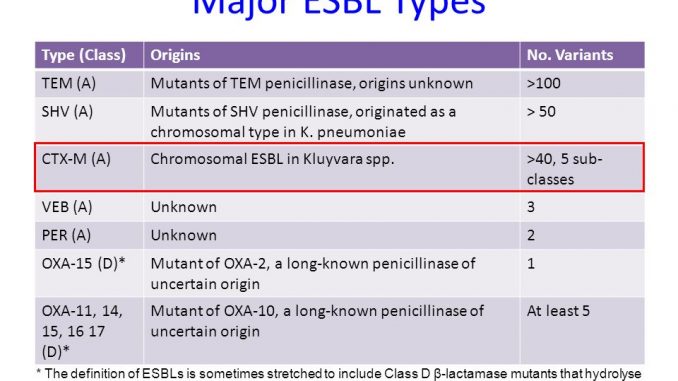
ESBL (Extended Spectrum beta-Lactamases) and types
- Extended spectrum Beta-lactamase are enzymes belongs to molecular class ‘A’ or ‘D’ and functional group 2b e and 2d. These enzymes hydrolyses penicillin, cephalosporin (1st, 2nd and 3rd generaion) including Aztreonam. However they are inactivated by clavulinic acid ad cephamycin (cephoxitine and cephotetan).
Types of ESBL
1. TEM type ESBL (Temoneira)
- This type of ESBL is commonly produced by coli and Klebsiella pneumonia, but also has been noted in Neisseria gonorrhoae and Hemophilus influenza.
- All TEM type ESBLs are derived from TEM-1 and TEM-2
- TEM-1 can hydrolyze ampicillin with greater extent but has negligible activity against extended spectrum cephalosporins. It is inhibited by clavulinic acid
- TEM-2 has same hydrolytic profile as TEM-1 but has different isoelectric point.
- There are more than 140 TEM type ESBl. However most common type of TEM ESBL are TEM-10, TEM-12 and TEM-26
- Amino acid substitution in active site of enzyme is responsible for ESBL, which results in allowing excess amount of Oxy-imino-β-lactams.
2. SHV type ESBL (sulfhydryl variable)
- SHV type ESBL resembles 80% to type TEM
- SHV type is usually produced by Klebsiella pneumonia and other enterobacteriaceae.
- SHV type are produced as a result of amino acid substitution at position 238 and 240.
- More than 80 different types of SHV have been identified. Most common SHV type are SHV-5 and SHV-12
3. CTX-M type ESBL (Cefotaximases)
- CTX-M type ESBL shows more affinity towards cefotaxims than other Oxyimino-β-lactam antibiotics.
- Most common type of CTX-M are CTX-M-2, CTX-M-3, CTX-M-14, CTX-M-15
- They are usually produced by coli and Salmonella enterica serovar Typhimurium
4. OXA type ESBl (Oxacillinases)
- OXA type ESBl are usually produced by Pseudomonas aeroginosa but have been detected in other gram negative bacteria also.
- This OXA type ESBL belongs to class ‘D’ and functional class 2d.
- It is characterized by hydrolysis rate for cloxacillin and oxacillin greater than 50% than for benzylpenicillin.
- They show reduced inhibition to clavulinic acid
- Most OXA type beta-lactamase do not hydrolyse the extended spectrum cephalosporin to significant degree and are not regarded as ESBLs. However OXA-10 hydrolyses cefotaxime, ceftriaxone and aztreonam.
- Most common type OXA type ESBL are is OXA-11, OXA-14, OXA-16, OXA-17, OXA-19, OXA-28, OXA-31, OXA-32, OXA_35, OXA-45
5. PER type ESBL:
- It share only about 25-27% homology with TEM and SHV type ESBL
- PER-1 can effectively hydrolyse penicillins and cephalosporins and is susceptible to clavulinic acid
- PER type ESBl is produced by Pseudomonas aeroginosa, Salmonella enterica serovar Typhimurium , Acinetobacter, Vibrio cholera, Klebsiella pneumonia, Proteus mirabilis
6. Other ESBL types are:
- VEB
- BES-1
- VIM-1
- GES
- TLA
- IBC
- SFO
